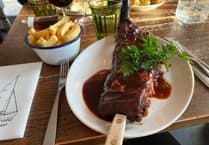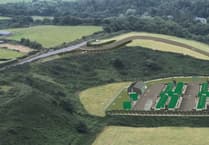John Teare of Peel, a cousin, and his family are to be thanked for providing hospitality for this great speaker, who spoke on Teare & Sons, Ships’ Chandlers and Sailmakers of Peel.
Michael was awarded his doctorate in marine biology, helping his research into fishing.
However, he seemed to have migrated to France with a career in the medical device industry. He took a year off to research his family history and he certainly made good use of this time.
Manx National Heritage had a mass of helpful material including sales ledgers from the 1860s. Michael used these and a wealth of other resources, including very early photographs that we really appreciated.
Much of this material had been delivered to the North Atlantic Fisheries Association in a lecture about his grandfather, his ship chandlery, sail and rope- making business. We, in Peel, are familiar with his memorial, Freddie Teare’s Steps, opposite the car dealers on the quay. He lived from 1890 - 1964. Look for the memorial plaque on the harbour wall. The business was centred on the present garage buildings.
In 1826, no fewer than 2,500 people were involved in fishing from Peel.
In 1883, this industry was featured in a large fishing exhibition in London.
Thomas Huxley claimed that fishing was inexhaustible. Many said he was wrong at the time, as signs of over-fishing were already apparent.
His reputation suppressed dissent. How wrong he was is all too apparent, today.
In 1892, Port Erin Marine Biological Station was opened, in conjunction with Liverpool University. How can this remain closed, with ever-increasing need?
The percentages of the British population, in the late 19th Century, involved in fishing makes interesting reading: England 1%; Scotland 9%; Ireland 3%; Isle of Man 25%.
The coming of the railway to Peel in 1873 made a huge difference as Peel could readily transfer the catch to other ports, including exports.
Steam vessels were now taking the catch to more distant markets. Boat building was increasingly important with some boats being towed away to have engines fitted.
To give some idea of the increasing importance of Peel, the population was 3 800 out of a national figure of 53 500.
Teare’s were involved in boat -building, including schooners, some of which were involved in the abhorrent but profitable slave trading.
They also built up a substantial property portfolio.
Several sons were killed in the First World War but the business continued until 1964 on a much-reduced scale.
What an incredible story for just one Peel business when, apparently, its founder, John Teare signed with an X, being illiterate but a brilliant entrepreneur.
This was a fascinating evening with a packed audience.
Our next meeting sees us as guests at the old Patrick School, for a tour of the new Knockaloe Centre with an optional stroll on the campsite, opposite. Meet at the old school in good time for a 7.30pm start on Wednesday, June 20.
John Slater





Comments
This article has no comments yet. Be the first to leave a comment.